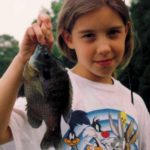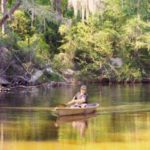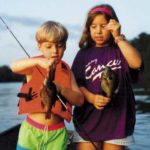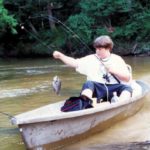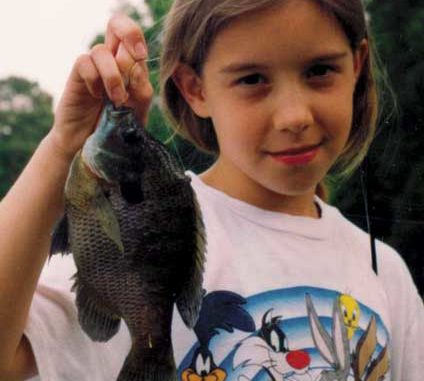
Beat the heat this month by floating the scenic, fish-filled streams on the North Shore.
As we headed out the garage door with our poles, my son Robbie and I waved to Shirley, but she remained oblivious, gabbing away on her cell phone about the movie “Sex and the City.” I’d heard and read that men across the English-speaking world are bashing this “chick flick” mercilessly — without having seen it. So I read a review in the New York Times by some hoity-toity feminist, who also bashed it. Then I realized that the males slamming it are either woefully misinformed or complete jackasses.
“The male characters in the movie stand idly by, either smiling or stripping, reduced to playing sock puppets. I’m all for the female gaze, but, gee, it’s also nice to talk — and listen — to men, too.”
Hope I’m not reading it wrong, but it seems here’s a wildly popular chick flick (predictably derided by a hoity-toity New York Times feminist because of its very popularity with the unwashed masses) that treats men as inanimate and discardable sex objects.
In other words: It broadcasts to millions upon millions of women that it’s fine for us to get up, shuffle to the fridge for beer and a kosher pickle, then click on the football game, while we wearily ignore their whiny entreaties.
And it’s being hailed to high heavens by women from 16 to 60 across the English-speaking world.
And American men are complaining to high heavens about this movie??!!
These musings occupied me as we bumped down the road to launch the ’rogue. Ah! Just as I thought. Rufus was fishing. A good sign. No one knows when the fish are biting in the upper Tchefuncte (north of 1-12) like Rufus. I’ve learned more from him than from any biologist.
There’s no mistaking Rufus’ truck. The thing came off the assembly line with Truman in the White House. Archaeologists would have a field day digging through the artifacts in the backbed. I found some Dixie 45 and Regal beer cans for my collection, an “I Like Ike” button, an umbrella turned inside out by Hurricane Betsy, a defunct football autographed by Ernie “the Wheel” Wheelwright, a Vic Schiro bumper sticker, an ancient mule harness — a veritable treasure trove for the antique aficionado.
“Hey Dad,” Robbie pointed as we pulled up alongside the vehicle. “What’s that coathanger doing in the …?”
“Hey Rufus!” I yelled while getting out. “I see ya finally fixed the antenna.”
“Hey, hey man!”
He swiveled from his seat atop the white bucket and fixed us with his famous blinding smile.
“Whatcha say Hom-Boy-Da? Brought the youngin’ too. Whatcha say, big guy? Can’t call you ‘little fella’ any more, can I?” Rufus chucked as Robbie towered over him.
I’d met Rufus on a soggy afternoon a few years before when I started canoe and pirogue fishing the upper reaches of the Florida Parish streams. Motorboats can’t get much past Highway 21 on the Tchefuncte and Bogue Falaya rivers. Bedico Creek north of 22 is impractical for most outboards. Blowdowns and gravel bars block the way in the Tangipahoa north of 190. A little north of Lacombe, Bayou Lacombe turns into a clear water creek. This means intrepid bank, wade and paddle fishermen have these streams to themselves.
This means virtually untapped fishing in some areas, and gullible fish. Add a stupefying backdrop of mixed upland and swamp scenery, cool flowing waters to offset the July heat, a backbeat of woodpeckers pecking and native woodies squealing instead of outboards and jet-skis roaring, and you’re talking fishing like the cliches describe it.
Alas, Katrina did a horrible number in these areas with blowdowns, making the already difficult access downright impossible for a while. Just recently the upper Tchefuncte was cleared of most blowdowns, giving us access again.
Conventional wisdom has always said to forsake freshwater fishing after a hard rain. Some mumbo-jumbo about the pH balance, barometric pressure, turbidity, etc. One day, desperate to escape the travails of domesticity, I came out after a rain anyway, and while launching my ’rogue, encountered a placid figure on a white bucket watching two corks while softly whistling to himself.
“Anything bitin’?” I asked.
“A few,” he nodded. “Justa few. I gots a few red-bellies (long-eared sunfish). A few poiches (bluegill). A few cats (channel catfish).”
A few indeed. He lifted the board, and I peeked inside. It was more fish than I’d caught from a bass boat two days before. It was more fish than most of the boats I queried at the Menetre boat ramp had caught.
Rufus employs an archaic but still effective fishing technique — natural baits (worms, crawfish, grass swimps) and patience. Amazing.
We think nothing of sitting in a tree for four-hour stretches three days in a row waiting for a deer to happen along. But in fishing, we insist on going to them. We roar in at 97 m.p.h., drop the trolling motor and make four casts. “Ain’t nothing here. I know a better place.” And we roar off again, then again and again. Sooner or later, we find them — usually after covering an area the size of Belgium and burning more fuel than the Space Shuttle, a not inconsiderable element to fishing trips nowadays.
So what happened to waiting for the fish to come to us?
Ask Rufus. He never lost the knack.
Anyway, I learned from my new friend Rufus that rain and (slightly) roiled waters offer some of the best fishing in the swift-flowing streams common to the Florida Parishes.
Seems that in these barren, sandy-bottomed streams without aquatic vegetation or adjacent swamplands, fish feed most actively when rain washes in food from the surrounding woods, branches and ravines. The rest of the time they have to make do with the few forage fish and insects along the banks.
These streams aren’t like those in the Atchafalaya or Maurepas basins, or in other similar swamps known as “spillover” wetlands. In these, high tides give the panfish access to that broth of fish fodder (minnows, crawfish, terrestrial and aquatic insects, larvae, etc.) that live in the shallow, fertile, weed-clogged pools and sloughs in the surrounding swamp.
In upland streams, the fish have to wait for the rain to wash this type of stuff in from the surrounding woods, branches, ditches, ravines, etc. The sound of rain is almost like a dinner bell to them. I heard all this from a biologist, and it made sense.
After chit-chatting with Rufus, Robbie and I carried the ’rogue to the water’s edge, put in the ultra-light spinning gear and jigging poles, the life preservers, the Playmate, the shrimp left over from the trip to Buras, the bucket of little live crawfish that the spotted bass native to these streams so love to inhale when hooked live through the tail and cast into the deeper eddies in sharp bends or under logs and stumps in the deeper holes.
Finally, we shoved off just as Rufus cranked in another channel cat.
“Way to go, Ruf!”
We did a thumbs up as the current took us around a bend and into another realm, where I started waxing philosophical on my surroundings.
Just think of it, I mused, every day tourists from around the world pay good money to sigh and gasp at the same scenery we often snore at on the way to a freshwater honey hole. A swamp maple blooming in vivid red is a thing of beauty to an engineer from London. To us, it might as well be a lightpole.
We study a twirling buzz bait rather than the towering, centuries-old cypress behind it. An alligator immersed in duckweed will cause a boatload of high-schoolers from Chicago to coo and shriek in wonder. All we do is smack our lips — we’d rather see the gator immersed in a sauce piquante.
We follow the path of a painted water snake with the crosshairs on a .22 rimfire rather than a zoom lens. A water moccasin bracketed by blooming white iris gets half a roll of snapshots from a Japanese accountant. From us, it gets three cylinders from the .357 magnum.
Now, these wood ducks blazing over at treetop levels provoke age-old questions: Where are they coming from? Where are they going? Why do they only fly 10 minutes of each day?
Drifting down a gin-colored (actually more like watery Dr. Pepper) stream with sandy banks and overhanging pines and water oaks, the cool water offsetting the July sun, my youngest offspring home from LSU and patiently imbibing my wit and wisdom with only periodic rolls of his eyes, the little cork dancing in the eddies. The current getting swifter. Then swifter.
Logs, stumps and blowdowns creating a picturesque obstacle course. More logs. A few bumping against the ’rogue now. A huge blowdown almost blocking the stream. The current getting still swifter.
“Hey Dad! Look at that log up ahead.”
“Never mind, son. We can handle it.”
The current getting still swifter. Ah, there’s a great blue heron flapping majestically from its perch atop a Katrina-killed pine.
Ah yes, nothing like an afternoon float trip to unwind.
“Paddle a little harder Robbie. Look at that heron. Isn’t it gorgeous?! And ya hear that woodpecker? Paddle a little HARDER now, son. HARDER! FASTER! I can’t seem to turn this … HARDER, SON! HARDER!”
“Dad! THAT LOG!! And there’s a SNAKE on it!”
“SNAKE! WATCH IT! Looks like a moccasin! Look OUT! Stick the paddle in! Come on! LOOOOK OUT!”
“HELP DAD!”
Thump! Splash!
“Grab the poles! The bucket! Hold on! Where’s my glasses?! Where’s the snake?!”
“There he is, Dad! He’s swimming at you!”
“AHHHH! Grab the paddle!”
SMACK!!
“Missed him! Try again!”
Fortunately the water was only 2-feet deep and the snake a diamond-backed water snake — hideous-looking but harmless. As a kid, I had six as pets.
We rounded up everything, even my glasses, and dragged it onto a sand bar.
Up ahead loomed our old honeyhole — a deep (5 feet or so) hole with a blowdown sticking out of it. Here’s the type of place you want to fish in these streams, and this is what simplifies this type of fishing. Most of these streams are shallow. The fish concentrate in the deeper holes that form, generally, where the stream bends. If it’s studded with a few logs or stumps, it’s almost guaranteed to hold fish.
What kind? Generally speaking, longeared sunfish (the colorful ones with bright orange bellies and turquoise-mottled faces some people call pumpkinseeds), spotted or Kentucky bass (a slightly slimmer, smaller and more silvery version of a largemouth), bluegills, sometimes spawning yellow bass and my favorite — channel cats.
I rigged up my ultra-light outfit with a piece of shrimp 4 feet under a little bobber (deep since I was going after catfish) on a thin panfish hook. We like the really thin ones so you can pull them free from snags, which is where the fish are. Robbie put on a little live ditch crawfish on a similar rig.
His cork hit the water and vanished while he was still flipping the bail.
“Set the hook, son!” I roared. “Set IT! You got him!”
“Coool!” he grunted. “Look at him go!”
He made a sizzling run into the shallows, then back toward the stump, then out of the water in a gill-shaking leap. Another leap. Another run. Some surface thrashing, then he was at our aqua-socked feet. A dandy of a spotted bass, barely 11 inches.
We put him in the fish basket, and I cast into the same hole. My cork bounced twice. A third time. There it goes! I reared back, and the little reel started singing. Then he hit the surface and started his tell-tale twirling routine. Yes, sir, a channel cat. Maybe a pound.
I nailed another in short order, as did Robbie, both on chunks of deceased shrimp — like we were croaker fishing in the lake.
Robbie cast a bit ahead of the blowdown, and caught a respectable (for us) orangebelly. These pugnacious little suckers love shrimp. And don’t ask me why. I mean, it’s not like it’s a natural part of their diet. I guess they taste close enough to crawfish.
Fishing with market shrimp is also a heck of a lot easier than threading crickets and worms on a hook after every tap.
We caught five more catfish, and continued downstream. Five fish per hole seems to be our average. Nothing spectacular, but we wouldn’t trade the experience for two boxes of Florida largemouths.
We had a ball, ending up with 23 fish. We’d float downstream looking for deep pockets and holes, then disembark onto a sand or gravel bank within casting distance, and have at them. We’d fish each hole for 15 or 20 minutes, maybe a snack and a cold drink, maybe a dip in the clear, cool water to refresh, then continue downstream. An utter joy, my friends.
Back at the truck after the trip, we found it had a dead battery. No problem. Just flip open the cell phone, call the little lady and request she drive down a muddy, desolate country road to deliver the jumping cables I so thoughtfully keep in her car’s trunk.
Shirley was absolutely delighted to hear from me, especially as she was already running late on her way to meet her friends for pre-movie drinks. The movie, naturally, was Sex and the City; the drinks, naturally, cosmos.
Hopefully her mood brightened somewhat after a few sips.
